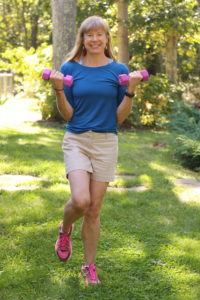
We all strive to find balance in life. In a physical sense, it’s central to everything that we do from walking to surfing and from gardening to high-intensity sports.
The clinical definition of balance is the ability to maintain the center of gravity over your base of support. For both elders and athletes, this translates into being able to avoid falls. But balance is not just something you either have or lose. It is something you can improve through exercise.
Balance is an interaction between the sensory information you receive and the movements you make to maintain equilibrium. Your eyes give you visual feedback about your position in the environment. Your inner ears sense the movements of your head. Nerve receptors in your muscles and joints detect your body’s trajectory. Your brain integrates all this, decides what to do about it, and commands your muscles to action.
Keeping your balance gets harder with age. That’s partly because the quality of one’s sensory input is affected by changes in vision, hearing, and proprioception (the ability to sense position and motion). Strength, flexibility, and reaction time decline, too.
A less tangible factor here is the fear of falling. When your mind starts believing that your balance is bad, your body begins to follow suit. One of the biggest risk factors for falling is the fear of falling.
Does this mean we are all doomed to unsteady futures? No. Research has shown that balance loss stems more from inactivity than from aging. With regular exercise, balance can be improved throughout our lives.
Many of our equilibrium reactions involve the ankles and hips, so targeted strengthening here is very effective. It’s also good to give your body some novel challenges, creating situations that make you feel somewhat unstable so that your body has a chance to practice the movements needed to bring yourself back into balance.
Here are a few exercises you can work into everyday life as you move around your house or yard. I especially like the kitchen for these activities, since you can use your hands to hold the sink or counter as needed, gradually progressing to less support as your balance improves. Out in the yard, you might find a friendly tree for support. Remember, you want to feel slightly unstable, but you also want to be safe.
Heel to toe: Slowly rock back and forth from toes to heels 10 to 15 times. Move slowly enough that you feel the muscles of the lower legs working. Notice what happens as you shift your weight forward and backward and what it feels like when you come back to the middle. For more of a challenge try this on a balance pad.
Crab walk: Sidestep the length of the kitchen, keeping your toes, hips and shoulders facing straight ahead, then return, leading with the other leg. Be careful not to rock your upper body from side to side. Notice the sensation in the muscles of your hips and buttocks. A more athletic variation would be to use a loop band at the ankles for resistance, or to increase to jogging or running speed (the beach is clearly better than the kitchen for this variation).
Reverse step: Walk backwards the length of the kitchen. This one will also strengthen the muscles of your hips and the backs of your legs. Feel how different it is to be moving your center of gravity backwards. Increasing to jogging or running speed is the way to ramp up the challenge on this one.
One-foot balance: Try to stand on one leg for 10 to 20 seconds; then switch legs and repeat. You can use one or both hands as needed. Too easy? Try it with your eyes closed! Athletic types may want to combine this with an upper-body weight series.
If you have questions about your ability to exercise, consult your health care provider before beginning a new routine. And forget about “no pain, no gain” — exercise does not need to hurt to work.



